THE MENKAURE TRIAD
Special for THE NEW TIMES HOLLER! By
© Amir Bey, 2009
MARCH 26
|
The Menkaure Triad is an ancient Egyptian sculpture suggestive of movement and sound. Graywacke Metasandstone, Egyptian Museum, Cairo
Photo from The Metropolitan Museum of Art Catalogue, EGYPTIAN ART IN THE AGE OF THE PYRAMIDS, 1999 |
THE TRIAD OF MENKAURE
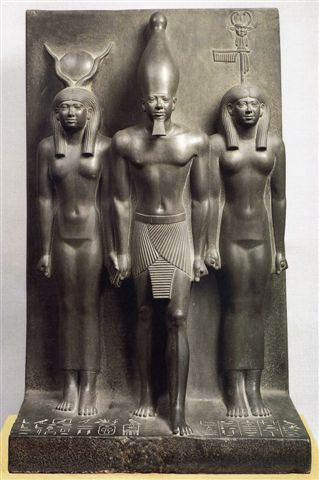
|
The 4th dynasty pharaoh, Menkaure  , "Eternal like the Souls of Re," was the builder of what is known as the third pyramid, the smallest of the three pyramids at Giza in Egypt. He was the son of Khafre  , "The Appearance of Re," builder of the second pyramid, and the Great Sphinx, and the grandson of Khufu  "Protected by Khnum," the builder of the Great Pyramid at Giza.
While his pyramid is small compared to his predecessors', a series of remarkable sculptures, The Triads of Menkaure, are of the finest in pharonic Egypt's more than 3,000 year history. Carved out of granite-hard Egyptian graywacke metasandstone that is slate gray-black in color, the Triads feature the pharaoh between the goddess of joy, passionate love, and fertility, Hatora (Hathor), who was a celestial and a terrestrial deity on his right, and on his left another deity, usually a female, who represented a particular nome or province.
Above and behind the head of the provincial deity the emblem for its region was carved. This article features photos of triads from two of those provinces. Hatora is often shown in her association with the sky and earth simultaneously, as a cow with stars on her body, or a human face with cow's ears. In the two examples shown here, she is wearing a solar disk with cow's horns.
|
Graywacke Metasandstone, Museum of Fine Arts, Boston
Photo from The Metropolitan Museum of Art Catalogue, EGYPTIAN ART IN THE AGE OF THE PYRAMIDS, 1999 |
THE PAIR: Egalitarian
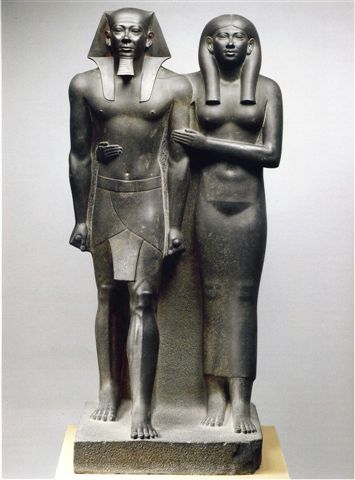
|
There is also a sculpture that I call "The Pair," that has similar stylistic elements, but is free standing with no back wall. It has slight traces of paint, which suggests we may be looking at the underlying form of a once brilliantly colored sculpture.
Peter A. Clayton on page 59 in his Chronicles of the Pharaohs identifies her as Queen Khamerernebty II  , "Beloved Appearance of the Two Ladies." Note that during the Old Kingdom only the pharaoh had his name written in a cartouche; that changed during the Middle Kingdom. It is likely a portrait, and it's reasonable to assume that it is the queen's.
The same face is used in all renderings of Hatora in the Triad Series, and for the face of the female regional deities. The equality of The Pair is remarkable because most Egyptian sculptures of queens and wives are significantly smaller than the pharaohs'. Queen Khamerernebty's portrayal as Hatora in the Triad series has elevated her to the level of the divine Pharaoh's, which could be seen as a tribute to her, and certainly says something about her status at the time.
|
Another installment of the Triad Series; all of them are of Graywacke stone. Egyptian Museum, Cairo (photo, Amir Bey) |
MENKAURE TRIAD
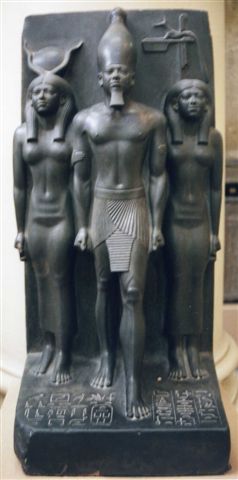
|
I first saw The Triad and The Pair in 1999 at the extensive exhibition Egyptian Art in the Age of the Pyramids, by The Metropolitan Museum of Art in New York City, which focused on art from the Old Kingdom. The accompanying catalogue has some of the photos shown here.
One perspective is that the Pharaoh (male) is almost supported by the hands of the Queen (female).
There are many examples in ancient Egyptian religion and art of the Pharaoh as a phallic entity whose virility is revived and sustained by the female. The story of Auset (Isis) putting her husband Ausar's (Osiris's) fifteen severed body parts together, with the final 15th, the phallus, she conceived Heru (Horus) who later avenged his father's murder, is an example.
The support or sustenance of the male by the female can be seen in the stances and almost bracing hands of the goddesses in the Triad and The Pair sculptures .
|
Egyptian Museum, Cairo. photo, Amir Bey |
Detail of a Triad, 2008
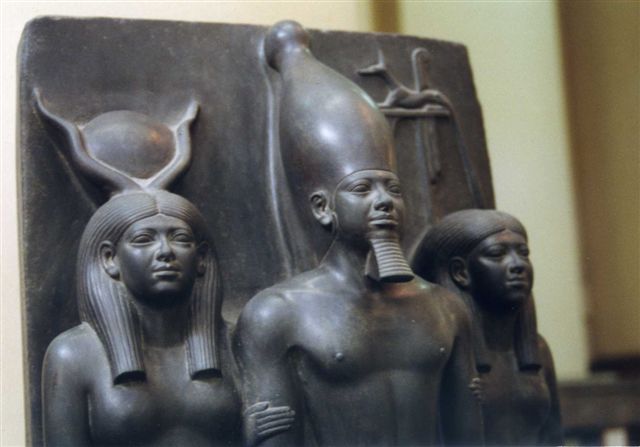
|
I was mystified the first time I saw the photos of the triad series, imagining what could have been happening in such a procession! And when I finally saw them they seemed to evoke sound and movement. It is not certain that The Triads were portrayals of a specific ceremony. Their purpose may have only been to represent the majesty of the Pharaoh and his link with the divine Hatora for localities that were associated with her.
So, permit me to speculate about the sound and movement of The Triads! My feeling is not as cosmic as
Sun Ra's might have been, who I saw strutting and singing with the vocalist and dancer June Tyson years ago.
The nature of the rite could have been celebratory. While the sculpture's tone is formal, it is not severe. The upright, firm figure of the pharaoh is massive and central. The White Crown of the South, the Shemas  or  that Menkaure wears gives him visual dominion over his two partners, and adds an expansive air. This is unlike the equality that I felt about The Pair.
|
Alabaster, Museum of Fine Arts, Boston
Photo from The Metropolitan Museum of Art Catalogue, EGYPTIAN ART IN THE AGE OF THE PYRAMIDS, 1999 |
MENKAURE AS A YOUNG MAN, 2007
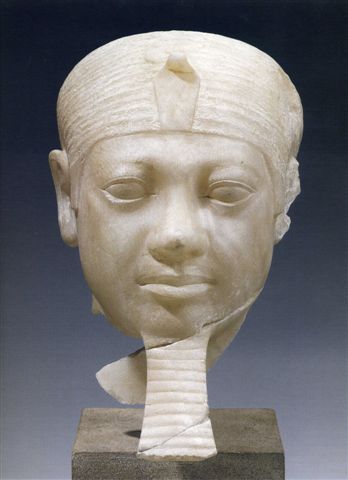
|
Movement: is suggested by the White Crown, the Shemas,  it's contours and length, the details of Menkuare's musculature, the reflection of light from the stone, and in contrast between the static appearance of the rendering of the nms  , headdress - likely made of a flexible material- which is worn in The Pair versus the contours of the Shemas, one can imagine the Shemas's accentuation of Menkaure's head's movement, turning and bouncing with each step, or his head could have turned rhythmically in a proscribed manner as he stepped in a procession.
Sound: bass tones from drums and stringed instruments being plucked could have marked the cadence of the steps taken by The Triad: symbols, gongs, bells, flutes and vocals could have enriched and enhanced those rhythms. Horns are possible, and there is a high-pitched
silver horn that was found in Tutankhamun?s tomb that gives us an idea of how one ancient Egyptian horn sounded like.
Combination of Movement and Sound: As the Triad walks, the bounce from Menkaure's steps caused the Shemas to vibrate. While none have survived, let's assume that the Shemas was made from a light material such as cotton, it likely wasn't altogether stiff, yet firm enough to hold its shape, and likelymoved in relation to the steps of its wearer. Finally, it is the curvatures of the deities' and Menkaure's forms and his Shemas crown that suggest sound and movement to me. A procession is also suggested by the two accompanying deities at his side and slightly behind him.
In the Triad of Menkaure, the twin features of the deities flanking the Pharaoh emphasize his individual significance. They are slightly behind him as they balance the image; they can be likened to wings, as they support and enhance him as he leads the way. They are part of the ceremony but are not co-equal as in The Pair sculpture. The role of Khamerernebty II in that sculpture is more pronounced. She seems to be a partner to his power: as she holds him she seems to present the Pharaoh, who stands as a static deity.
There is relatively less movement suggested in The Pair sculpture when compared to The Triads. The Pair are standing in the traditional pose with the left foot forward, and movement is suggested in Menkaure's knees down to his feet, with his toes slightly spread apart. His arms allude to walking, yet the rest of the figures of The Pair imply little or no movement. This contrasts with The Triads' evocation of ceremony. While The Pair and The Triads are undoubtedly portraits, The Triads' rendering of Menkaure is consistent with the Egyptian alabaster head "Head of King Menkaure as a Young Man" with its round nose and eyes, while the Menkaure of The Pair has sharper features that seem slightly more idealized in comparison, but still give the impression that they are of the same person.
|
|
|
|
|